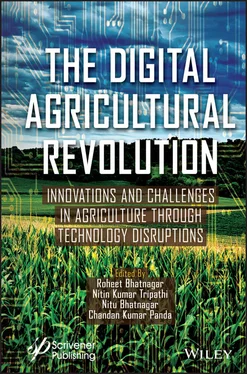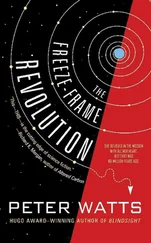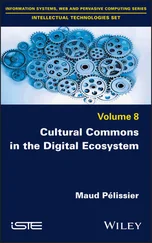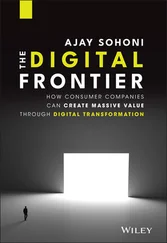Beverly, MA 01915-6106
Publishers at Scrivener
Martin Scrivener ( martin@scrivenerpublishing.com)
Phillip Carmical ( pcarmical@scrivenerpublishing.com)
The Digital Agricultural Revolution
Innovations and Challenges in Agriculture through Technology Disruptions
Edited by
Roheet Bhatnagar
Nitin Kumar Tripathi
Nitu Bhatnagar
and
Chandan Kumar Panda

This edition first published 2022 by John Wiley & Sons, Inc., 111 River Street, Hoboken, NJ 07030, USA and Scrivener Publishing LLC, 100 Cummings Center, Suite 541J, Beverly, MA 01915, USA
© 2022 Scrivener Publishing LLC
For more information about Scrivener publications please visit www.scrivenerpublishing.com.
All rights reserved. No part of this publication may be reproduced, stored in a retrieval system, or transmitted, in any form or by any means, electronic, mechanical, photocopying, recording, or otherwise, except as permitted by law. Advice on how to obtain permission to reuse material from this title is available at http://www.wiley.com/go/permissions.
Wiley Global Headquarters
111 River Street, Hoboken, NJ 07030, USA
For details of our global editorial offices, customer services, and more information about Wiley products visit us at www.wiley.com.
Limit of Liability/Disclaimer of Warranty
While the publisher and authors have used their best efforts in preparing this work, they make no representations or warranties with respect to the accuracy or completeness of the contents of this work and specifically disclaim all warranties, including without limitation any implied warranties of merchant-ability or fitness for a particular purpose. No warranty may be created or extended by sales representatives, written sales materials, or promotional statements for this work. The fact that an organization, website, or product is referred to in this work as a citation and/or potential source of further information does not mean that the publisher and authors endorse the information or services the organization, website, or product may provide or recommendations it may make. This work is sold with the understanding that the publisher is not engaged in rendering professional services. The advice and strategies contained herein may not be suitable for your situation. You should consult with a specialist where appropriate. Neither the publisher nor authors shall be liable for any loss of profit or any other commercial damages, including but not limited to special, incidental, consequential, or other damages. Further, readers should be aware that websites listed in this work may have changed or disappeared between when this work was written and when it is read.
Library of Congress Cataloging-in-Publication Data
ISBN 978-1-119-82333-9
Cover image: Pixabay.Com
Cover design by Russell Richardson
Set in size of 11pt and Minion Pro by Manila Typesetting Company, Makati, Philippines
Printed in the USA
10 9 8 7 6 5 4 3 2 1
The practice of agriculture began in ancient civilizations and farmers have always contributed to nation-building by growing produce to feed an ever-growing population. Moreover, agriculture is the foundation of an economy, providing livelihoods for millions of farmers. Therefore, there is a need for synergy between application of modern scientific innovation in the area of artificial intelligence (AI) and agriculture, while taking into consideration the major challenge brought on by climate change, viz., rising temperatures, erratic rainfall patterns, emergence of new crop pests, droughts, floods, etc. The intent of this edited volume is to report high-quality research (practical theory, including prototype and conceptualization of ideas, frameworks, real-world applications, policies, standards, psychological concerns, case studies and critical surveys) on recent advances toward the realization of a digital agricultural revolution resulting from the convergence of different disruptive technologies.
This book highlights the latest achievements in the field of modern agriculture, which is highly driven by technology and aimed at sustainable agriculture. In it is a collection of original contributions by researchers/ academicians from across the globe regarding state-of-the-art solutions using newer methods to enhance and improve crops for smart agriculture. These solutions are arrived at by various means, as indicated in the topics covered in the twenty chapters described below.
– Chapter 1presents an overview of how AI helps to increase socio-economic and environmental sustainability in the Indian agricultural sector. It also highlights the AI practices incorporated by farmers in India with small and medium-sized agricultural lands.
– Chapter 2describes the high efficacy of using remote sensing images and neural network models to generate accurate crop yield maps and offers proof of the significant superiority of neural network models over conventional methods.
– Chapter 3discusses the use of intelligent irrigation systems, which have recently gained importance in terms of efficient cultivation of plants and the correct use of Earth’s water. The use of machine learning and control methods in plant growth modeling and irrigation systems is also explained. The chapter ends with a discussion of current problems along with possible future implementation of new approaches to solve them.
– Chapter 4provides insight into the opportunities presented by the use of robots in agriculture, known as agribots, and focuses on the advancements in different types of agribots in terms of sensing, mobility, path planning, and manipulation. It also talks about the status and progress of robots in Indian agriculture, concentrating on Indian-based robotic startups and case studies involving the use of robots in harvesting crops along with the challenges faced when deploying robots in the field.
– Chapter 5delves into the Colombian palm oil (PO) industry. The contribution of this study is twofold: First, it provides a more comprehensive review of the PO industry technology literature based on Scopus and Clarivate Analytics, using the reporting checklist of preferred reporting items for systematic reviews and meta-analyses (PRISMA). Second, as far as the authors know, this is one of the first studies to address the technological solutions applied by Colombia’s PO producers and aims to help fill this research gap.
– Chapter 6presents a case on smart agriculture and discusses intelligent agriculture in a greenhouse-based multi-agent system (MAS), which is made up of several agents located in an environment that interact according to some defined relationships. In this work, each part of the greenhouse environment is represented by one or more agent, with each agent coordinating with other agents to achieve set goals. In addition, it discusses the society of agents in which two types of agents can be found: 1) reactive agents characterized by simple behavior, whose mission it is to perform tasks that do not require intelligent reasoning, and 2) cognitive or intelligent agents, which are tasked with performing more complex missions and require reasoning to make good decisions.
– Chapter 7is a study on the use of automatic and intelligent methods in the management of irrigation of agricultural land. Among these technologies are artificial intelligence and the Internet of Things (IoT), which are used to optimize the management of irrigation water in agricultural lands. The elements of the agricultural system and its environment are presented by things in direct contact with each other by relying on information and communication technology (ICT).
Читать дальше













